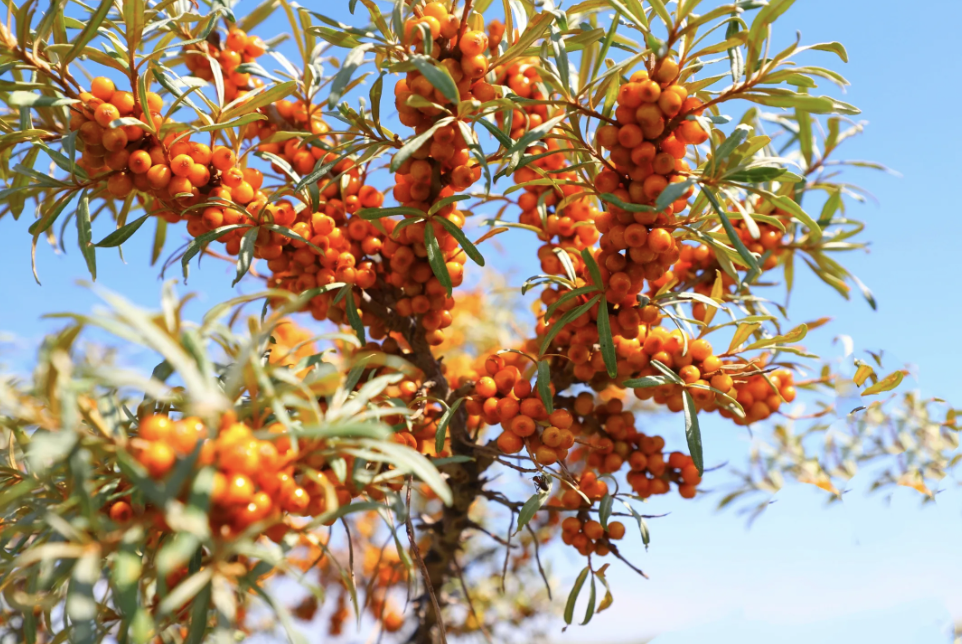Desert farming provides ecological, economic benefits
Huachi county in Qingyang city, northwest China's Gansu Province, is an important region in preventing the southward movement of sandstorms. In order to strengthen the ecological barrier, the county has been actively engaged in efforts to convert farmland into forested areas and combat desertification through the cultivation of sea buckthorn trees.
In the sandy fields of Chengguan village in Rouyuan township, Huachi county, Zhang Pengfei, head of a sapling planting farmers' cooperative, was busy pruning sea buckthorn trees.

Photo shows a Sea buckthorn tree. (Photo courtesy of the National Forestry and Grassland Administration)
"Sea buckthorn is one of China's first officially recognized plants with both medicinal and edible properties. It is packed with various nutrients and active compounds, in particular boasting high levels of vitamin C," Zhang explained.
"Sea buckthorn's adaptability is remarkable, making it a valuable tree species for combating desertification. We primarily focus on cultivating sea buckthorn seedlings, producing around 8 million seedlings annually," Zhang added.
Sea buckthorn trees can effectively stabilize sand.
"With their umbrella-like shape above the ground, the fallen leaves forming a blanket, and a well-developed root system resembling a net underground, sea buckthorn trees contribute significantly to soil and water conservation as well as nitrogen fixation, offering immense ecological value," explained Zhu Yajuan, a researcher at the Research Institute of Ecology Conservation and Restoration of the Chinese Academy of Forestry.
Apart from its ecological value, sea buckthorn also holds economic value.
Tian Cheng, deputy director of the Natural Resources Bureau of Huachi county, said that the county currently has over 450,000 mu (about 30,000 hectares) of land dedicated to sea buckthorn cultivation.
The annual yield of sea buckthorn fruits in barren hills can exceed 400 yuan (about $56.05) per mu, while in sea buckthorn orchards, it can surpass 1,000 yuan per mu.
During the spring and autumn seasons, nearly 2,000 villagers participate in sea buckthorn planting in the county, earning an average income of 9,000 yuan per person.
At a Malus pumila "Saiwaihong" demonstration base in Horqin district, Tongliao city, north China's Inner Mongolia Autonomous Region, rows of fruit trees are neatly arranged, their fruits shimmering in the sunlight.
"We began studying Malus pumila ‘Saiwaihong’ in the 1990s. The variety is able to withstand cold and drought, and thrives in sandy soil. It generates high economic benefits and is easily adaptable for widespread cultivation," said Wang Baoxia, deputy director of the Tongliao Institute of Forestry and Grassland Science.
"The cultivation area of Malus pumila 'Saiwaihong' in the village covers 1,500 mu, with a survival rate of over 95 percent. During peak seasons, the demonstration garden yields an average income of more than 5,000 yuan per mu. Moreover, the mature fruit trees play a role in guarding the area against sandstorms," said Li Yonghua, Party chief of Liaofeng village.
Tongliao city has 350,000 mu of land dedicated to the cultivation of Malus pumila "Saiwaihong." The fruit trees planted on over 100,000 mu of land are able to produce fruits, resulting in an annual production of over 100,000 tonnes of fruits. This contributes to an annual output value of nearly 500 million yuan.
In the sandy fields of Zhichan village, Xiqu township, Minqin county, Gansu, He Derong, head of a farmers' cooperative dedicated to the cultivation of cistanche deserticola, a traditional Chinese herbal medicine, was leading the villagers in inserting water pipes into the roots of saxaul trees.
Cistanche deserticola, a parasitic plant that relies on saxaul trees as its host, is renowned for its ability to control desertification.
Minqin county boasts suitable conditions for cultivating cistanche deserticola. Currently, the cooperative has expanded the cistanche deserticola planting area to 4,600 mu. Last year, cistanche deserticola growing on saxaul trees in Minqin county generated an output value of 12.72 million yuan.
The sandy fields not only provide a diverse range of food sources but also serve as a reliable supplier of high-quality feed for livestock.
Chinese wild rye is highly palatable and favored by both cattle and sheep.
Liu Hui, an engineer at the Institute of Botany, Chinese Academy of Sciences, who is currently stationed in Xiaojieji township, Kailu county, Tongliao city, explained that the Chinese wild rye cultivated by the institute boasts exceptional traits such as cold and drought resistance, and saline-alkali tolerance.
The grass is also effective at fixing sand. Calculations indicate that the grass can reduce soil erosion by wind by around 70 percent the second year after it is planted and by over 95 percent three years after it is planted.
Photos
Related Stories
- National Ecology Day special: Saihanba's green tales for the world
- Progress in turning China green
- China's afforestation improves ecology, increases local incomes
- Eco-friendly designs in China's major engineering projects
- In pics: guardians of endangered trees in SW China's Chongqing
- Forest ranger couple witness ecological improvements in east China
- Interview: China's development aligns rapid growth with ecological protection, says expert
- Hainan explores compensation mechanism for better conservation of rainforest
- Green energy boosts ecological, sustainable development in E China’s Jiangxi
- Deinanthe caerulca spotted in C China’s Hubei
Copyright © 2024 People's Daily Online. All Rights Reserved.









